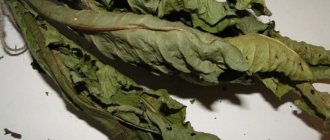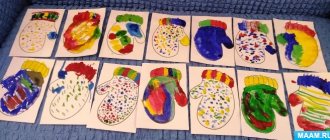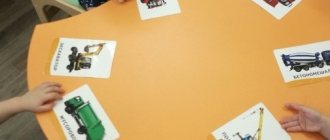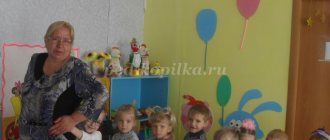Thematic lesson “Turnip” for 1.5-2 years
The fairy tale "Turnip" is one of the first children's books that parents begin to read to their baby. It’s more likely not to read, but to tell the story from the pictures. To make a child love and remember this story, you can play with the fairy tale from different angles. That's what we tried to do with our one and a half year old baby.
Games on flannelgraph
We also made a flannelgraph for our older child. The heroes of the fairy tale “Turnip” have still been preserved, although a little with the patina of time. However, this did not make them any less interesting for the younger one. First, we got to know the characters and simply learned how to attach them to a flannelgraph. A little later they were already trying to arrange the characters in the right order. True, my son prefers to immediately place the mouse after his grandfather. In the end, we managed to place everyone in the right order.
Studying the sizes
At this stage we teach the concepts of big, small, medium. They attached them to turnips. The child seated the bears and fed them turnips of the appropriate size: a large bear - a large turnip, a medium one - a medium one, a small one - a small one.
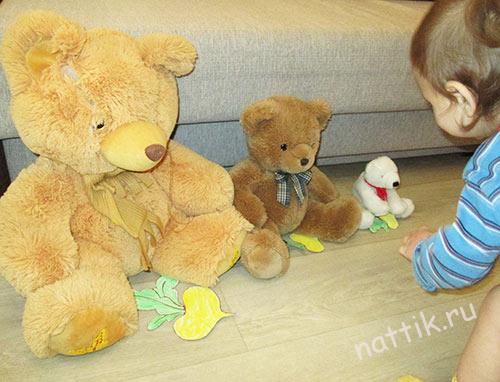
They also laid out the turnips from smallest to largest. This is how our turnips grew.
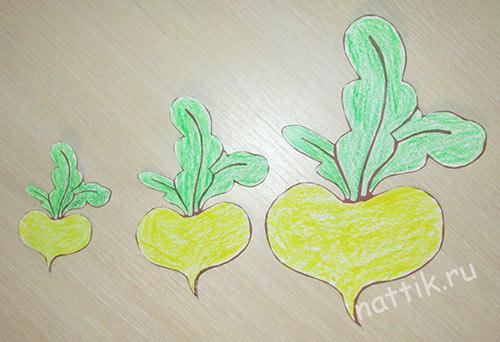
Find the outline
We selected the appropriate contours for the turnips.
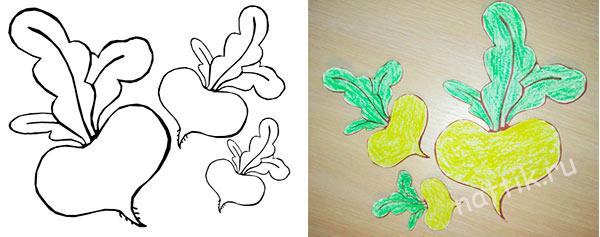
Games with clothespins For the game, we prepared a turnip without tops and green clothespins. The clothespins are not tight and can be easily opened by a child.
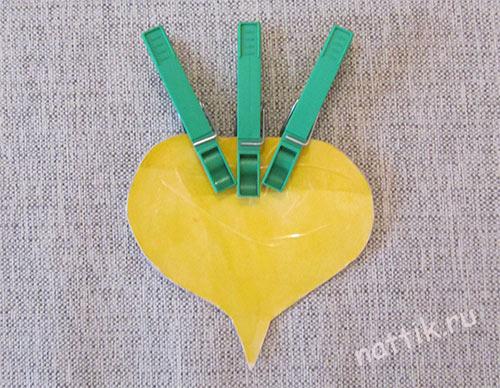
Playing with mosaics
For the game, we printed out the turnip coloring page on an A4 sheet of paper and colored it in the required colors. The sheet was placed on the board and several holes were made so that the child could see where the chips should be inserted. The task is to arrange the chips by color (make the tops green, turnips yellow).
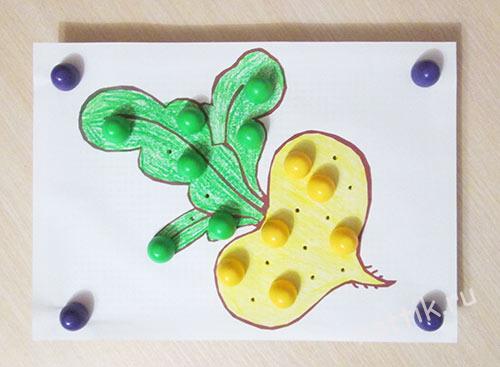
Who eats what?
They fed the heroes of the fairy tale. At the same time, they reinforced that the mouse loves cheese, the cat loves fish, and the dog loves bones.
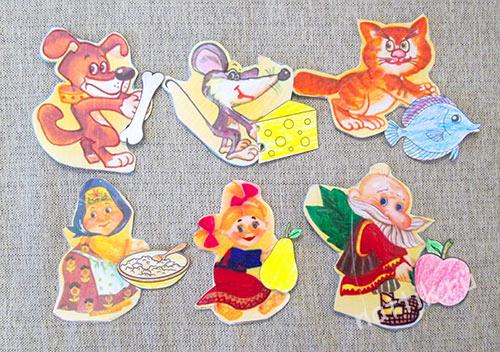
We are building a house
A house for the woman and grandfather was made from geometric shapes.
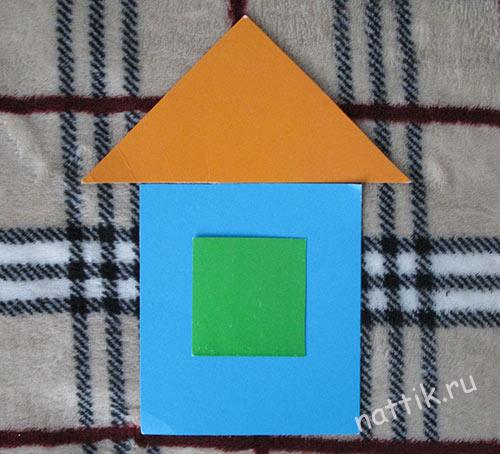
Let's play with the ball
We pass the turnip ball to each other. Mom says - the turnip is sweet, round, yellow, tasty. We learn to throw a ball and catch it.
Developing motor skills
We played with cereals and planted turnips in the garden bed. At the same time, we talked about what else was growing in the garden - we planted carrots, peas, and eggplant. We tried to lay out an even path with beans, but it didn’t last long.
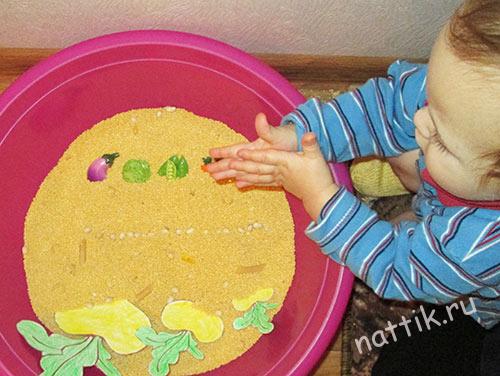
They sculpted turnips from plasticine, rolled sausages, and made beds out of them. Various vegetables and our turnips were planted in them.
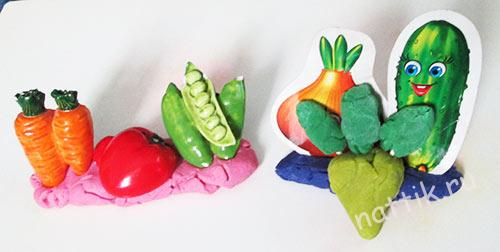
They cooked porridge for the woman and grandfather in a toy saucepan and spooned it onto plates.
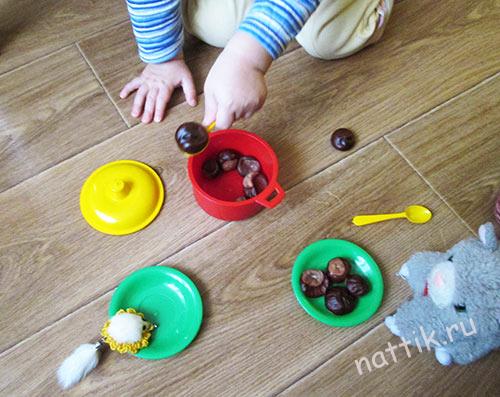
They fed the mouse buttons. A picture of a mouse was glued to the box and a hole was made - a mouth for it. I made the hole specially small so that small buttons could fit. We talked about sizes and saw that large buttons did not fit here.
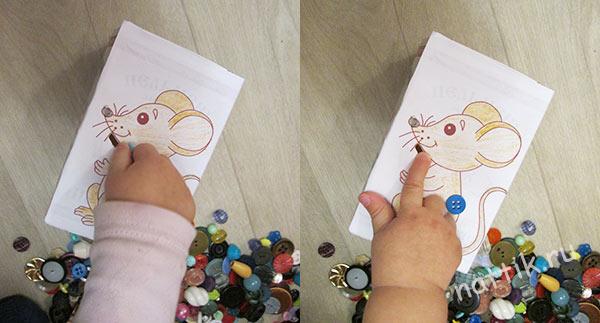
We string beads onto a cord and make a gift for our granddaughter.
Creation
They made a torn applique and decorated a turnip. Lately my son has become interested in this, which makes me very happy. He applies the glue stick so diligently!
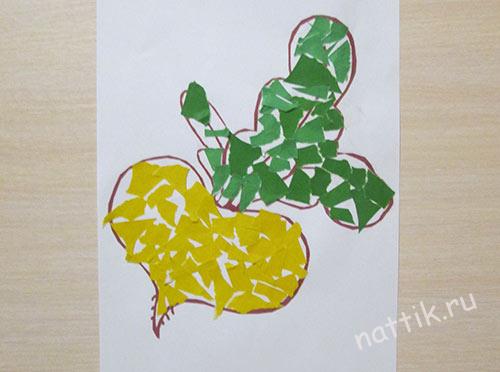
Of course, this theme can be further developed by adding other games and making them more complex. We are still small and can only cope with these tasks. Let me give you an example of what you can still do after 2 years:
- Gather vegetables – Place a variety of vegetables on the floor in front of your child. Ask him to give you the vegetable as described.
- Study the structure of turnips.
- Find captions for pictures of heroes
- Play logic games - continue the series, find a pair, etc.
Progress of the game.
Invite children to help grandfather go to the turnip , grandmother to the apple tree, granddaughter to the lake.
Didactic game “What happened to the cockerel’s tail?” based on the fairy tale by V. A. Sukhomlinsky “The Boastful Cockerel” 1. Acquaintance with the fairy tale by V. A. Sukhomlinsky “The Boastful Cockerel” 2. Guess the riddles Early, early, at dawn, Together with the sun, it rises. So that.
Didactic game based on the fairy tale “Kolobok” Hello colleagues! Sometimes even the most wonderful child gets bored with all his toys, books, puzzles and wants something new and interesting. Didactic game based on the fairy tale "Turnip" educational game based on the fairy tale "Turnip" I offer other game options. Didactic game “Who are you?” based on the fairy tale "Turnip". Tasks: activation. Didactic game based on the fairy tale "Teremok" Didactic game based on the fairy tale "Teremok" Purpose: to develop children's coherent speech, practice the use of ordinal numbers. The teacher shows. Game-dramatization based on the fairy tale “Turnip” Game-dramatization based on the fairy tale “Turnip”. The fairy tale is the oldest genre of folk art. A fairy tale teaches a person to live, inspires, inspires optimism.
Game-dramatization based on the fairy tale “Turnip” Lesson summary Game-drama based on the fairy tale “Turnip” in the younger group. Goals and objectives: To arouse interest in the fairy tale “Turnip”. Keep learning.
A dramatization game based on the fairy tale “Turnip”. A dramatization game based on the fairy tale “Turnip” in the first junior group “Rainbow”. Goal: to continue to introduce children to Russian folk tales. Encourage. Didactic game “Color” Goal. To develop children’s ability to select object pictures by color. Strengthen children's knowledge about color. Develop attention and memory. logical. “Find the place of the sound in the word.” Didactic game based on the fairy tale “Kolobok” Using the fairy tale “Kolobok”, you can teach children how to behave safely with strangers. And I, using this fairy tale, teach children to find. Didactic board game for speech development for children 2–3 years old, fairy tales “Turnip” and “Kolobok” Board didactic game (for speech development) for children 2–3 years old, fairy tales “Turnip” and “Kolobok” Tatyana Vladimirovna Mizeva, Elena Nikolaevna.
Source
Progress of the game.
One or two children are playing
Invite the children to guess the riddle:
Each other exactly in a row
Each has a window and an entrance,
Someone lives in everyone. (House)
Suggest the answer to the riddle be made from geometric shapes. Remind them that they need to use all the figures, then tell them what the house consists of.
Option 4. “Grow and harvest fruits”
Goal: development of elementary mathematical concepts and fine motor skills of the hands.
Progress of the game.
The teacher asks you to guess the riddle:
With a tail, not a mouse. (Turnip)
Children, together with the teacher, tell and paste pictures with fairy tale .
As a complication “Name the heroes of the fairy tale ”
Turnip - turnip.
Option 2. “Who is behind whom”
Goal: development of elementary mathematical concepts: first, then, first, second, last.
1. Learn to navigate in space.
2. Develop visual thinking,
3. Introduce the child to prepositions: for, before, before, after, between.
Progress of the game.
1) The teacher asks to place the characters in a certain sequence. For example: the granddaughter between the grandmother and the Bug; first the mouse, and then the cat. Next, he shows and explains to the child what each concept means and asks him to repeat it. After the children have mastered all the concepts, the game . The presenter asks to place the granddaughter behind the grandmother, the mouse last, the cat between the Bug and the mouse, etc.
2) If children successfully master all the concepts, you can complicate the game by adding the concepts of right and left.
Option 3. “Assemble from parts”
Target:. development of elementary mathematical concepts.
1. Fix the names of geometric shapes.
2. Develop fine motor skills of the hands.
